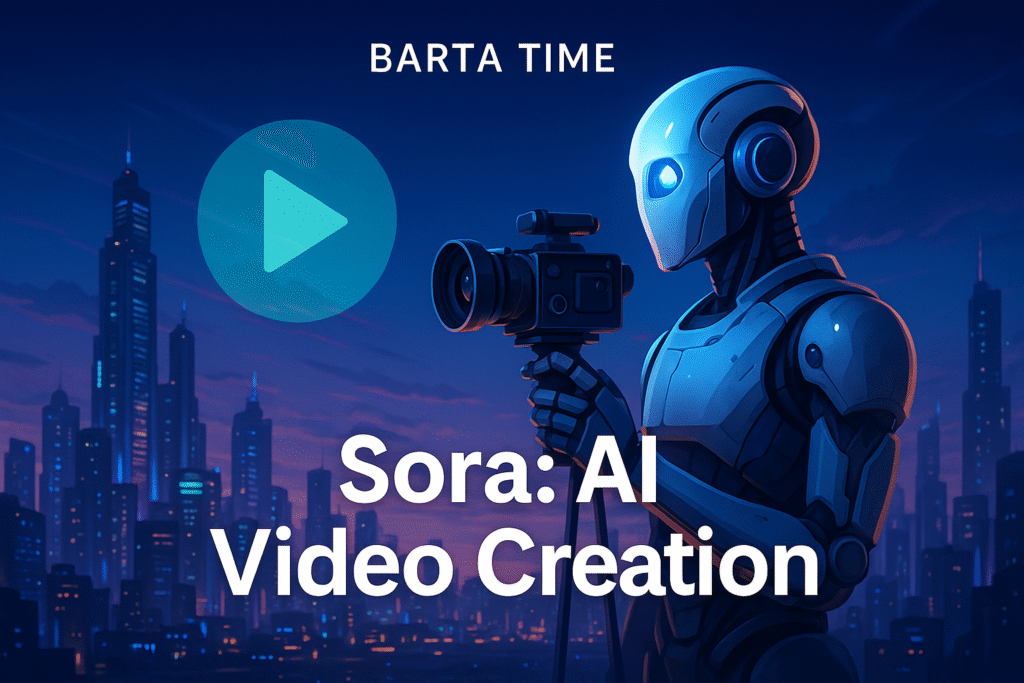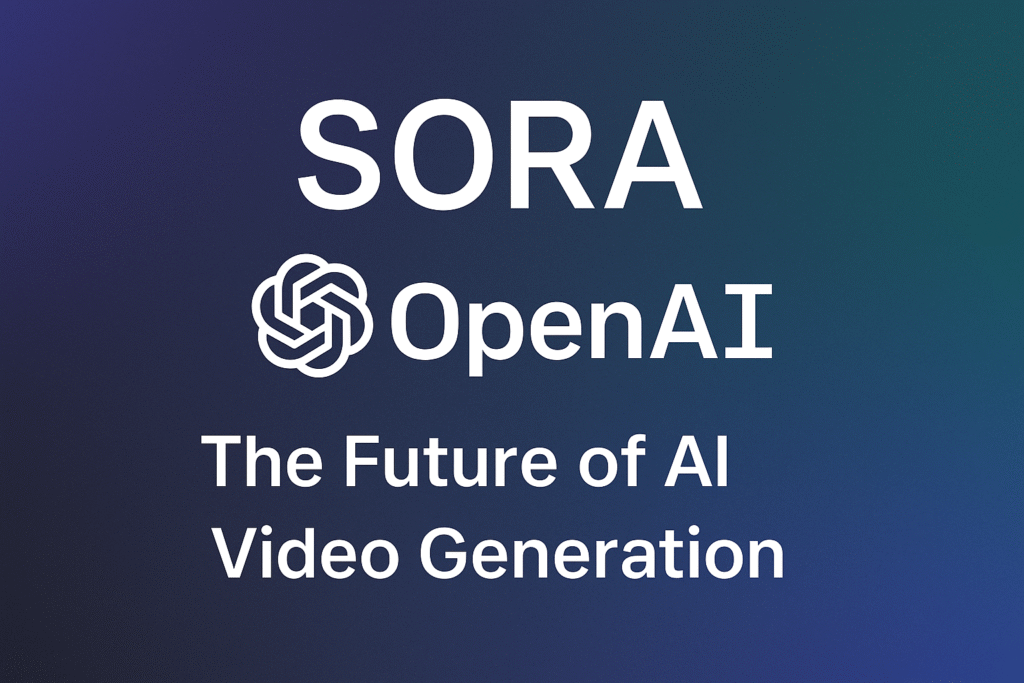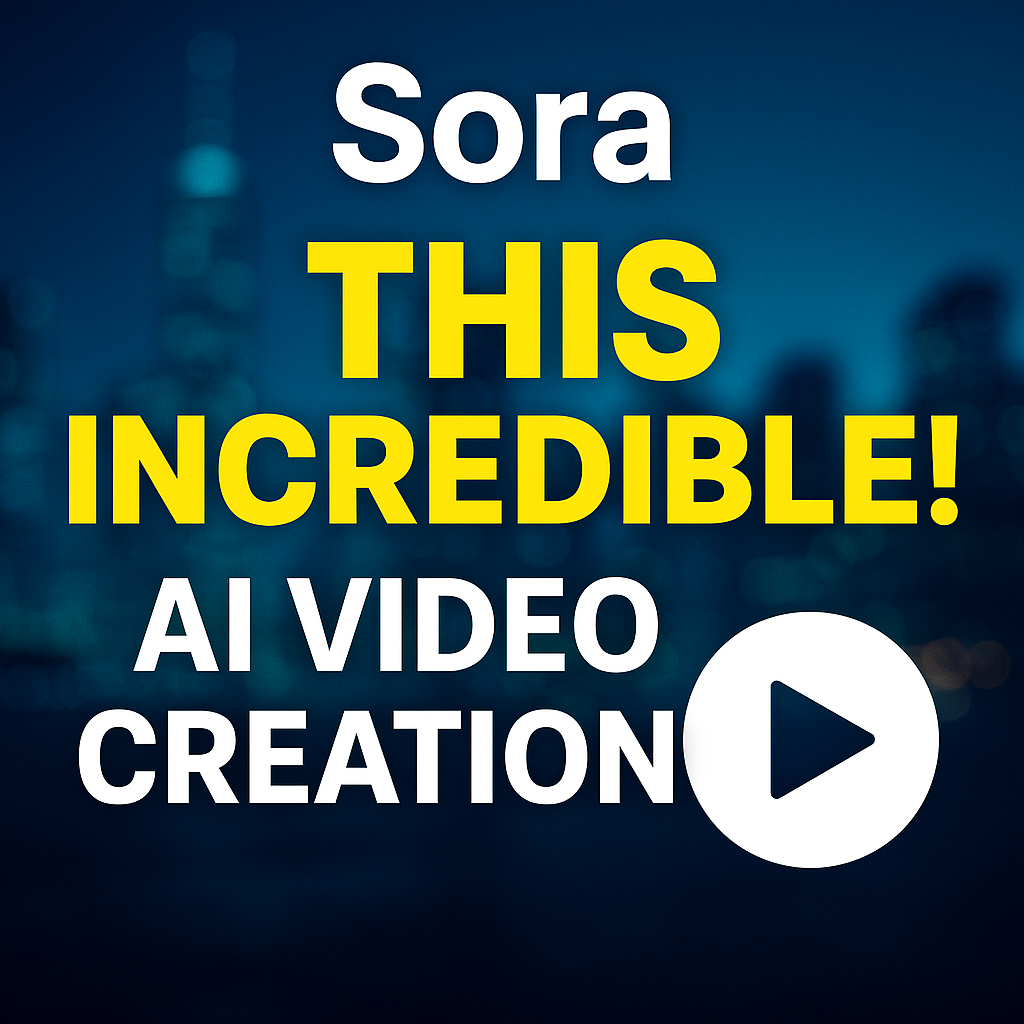
Sora by OpenAI: The Future of AI Video Generation (2025 Guide)
Discover OpenAI Sora – the powerful AI video generator transforming storytelling, marketing, and filmmaking in 2025. Learn features, use cases, pricing, and how to get early access.
🔥 Introduction: What is OpenAI Sora?
OpenAI’s Sora is a revolutionary AI video generation tool that turns text prompts into realistic videos. Introduced in 2024, Sora bridges the gap between imagination and high-quality video content—making it a game-changer for filmmakers, marketers, educators, and content creators.
With Sora, you can describe a scene like:
“A stylish woman walks down a rainy Tokyo street at night, neon signs glowing around her.”
…and within seconds, Sora creates a video that looks like it was directed by a professional cinematographer.
🎯 Key Features of Sora by OpenAI
| Feature | Description |
|---|---|
| Text-to-Video AI | Generate HD videos from simple natural language prompts. |
| Realism & Coherence | Understands physics, lighting, and camera motion. |
| Multi-angle Understanding | Creates scenes with accurate object relationships and spatial awareness. |
| Long Video Generation | Supports longer clips (up to 60 seconds) with consistent scenes. |
| Complex Prompt Handling | Understands and executes multi-part or abstract prompts. |
✨ What Makes Sora Unique?
- Uses transformer-based architecture similar to GPT-4.
- Can simulate cinematic camera effects like slow-motion, zooms, or dolly shots.
- Maintains logical storytelling throughout the video (object permanence, movement).
- Outperforms tools like Pika Labs and Runway in realism and coherence.

🧠 How Does Sora Work?
Sora is powered by a diffusion transformer model, which is trained on large datasets containing videos, images, and text captions. Here’s a simplified breakdown:
- Input: You provide a text prompt (e.g., “A time-lapse of blooming flowers in a desert”).
- Processing: The model uses deep learning to interpret the prompt, predict motion, colors, object relations, and scene progression.
- Output: Generates a high-resolution video (up to 1920×1080) in less than a minute.
It also supports frame interpolation and temporal consistency, making transitions smooth and natural.
🎥 Sora AI Video Examples
Some popular examples shared by OpenAI include:
- A mammoth walking across a snowy field.
- A robot dancing in a futuristic city.
- A drone flying over a canyon at sunset.
💡 Want to watch? See official demo videos here: openai.com/sora
💡 Use Cases of Sora AI
| Industry | Use Case |
|---|---|
| Filmmaking | Storyboarding, pre-visualization, or full scene generation. |
| Marketing | Product ads, explainer videos, viral content. |
| Education | Create historical reenactments, science visuals, or language tutorials. |
| Gaming | Concept cinematics or animated cutscenes. |
| Real Estate | Property walkthroughs, neighborhood simulations. |
📊 Sora vs Other AI Video Tools
| Tool | Strengths | Weaknesses |
|---|---|---|
| OpenAI Sora | Realistic motion, long clips, multi-object handling | Still in limited access |
| Runway ML | Easy interface, good for beginners | Less realistic physics |
| Pika Labs | Fast and creative outputs | Struggles with long or complex scenes |
| Google Veo | Great for landscape & cinematics | Still under development |
🔍 Sora outperforms in realism and spatial understanding, especially when prompts involve multiple characters or dynamic motion.
🧪 Limitations of Sora
Sora is powerful—but it’s not perfect:
- Inaccurate hand gestures or facial expressions in some outputs.
- Struggles with text overlay (e.g., creating legible signs or labels).
- Ethical concerns around deepfakes and misuse.
- Limited public access – still only available to select creators and researchers.
💰 Is Sora Free?
Currently, Sora is not publicly available. OpenAI has offered early access to selected developers, visual artists, and creative agencies for testing and feedback.
💸 Pricing (Expected)
While OpenAI hasn’t officially released Sora’s pricing model, based on GPT-4 and DALL·E, we can assume:
- Free tier (limited features)
- Pro tier for commercial use
- Enterprise tier with API access
Stay updated via: https://openai.com/sora
🚀 How to Get Access to Sora
Right now, you can’t directly sign up—but you can:
- Join the waitlist on the official OpenAI Sora page.
- Follow OpenAI on Twitter and LinkedIn.
- Apply for OpenAI’s creator program (available to artists, educators, and developers).
- Subscribe to newsletters like BartaTime.com for updates and tutorials.
📈 SEO Benefits of Sora-Generated Videos
For content creators and digital marketers, using Sora can improve:
- Engagement: AI videos keep visitors on your site longer.
- Rankings: Google values multimedia content (videos + blogs).
- Conversions: Well-crafted visual content can boost lead generation by 80%.
➡️ Consider using Sora-generated videos on YouTube, landing pages, or product demos.
🔐 Ethical Use of Sora
OpenAI is building guardrails to prevent abuse:
- Watermarking AI-generated videos.
- Content review systems.
- Policies against explicit, violent, or deceptive outputs.
As creators, we must promote responsible AI use to prevent misinformation and misuse.
✅ Pros and Cons of Sora
✅ Pros:
- Ultra-Realistic Video Generation
- Sora creates photorealistic videos that are often indistinguishable from real footage.
- Text-to-Video Simplicity
- Users can generate high-quality videos just by typing prompts—no video editing experience needed.
- Time-Saving
- Produces professional-quality videos in minutes, ideal for marketers, educators, and creators.
- Creative Freedom
- Supports imaginative and abstract prompts, allowing users to visualize concepts that are otherwise hard to film.
- Continuous Motion
- Sora maintains fluid motion and camera angles in one uninterrupted video clip.
- Context Awareness
- Understands complex scenes, physics, and character interactions with high accuracy.
- Great for Prototyping
- Designers and storytellers can quickly generate scenes for storyboarding or concept testing.
❌ Cons:
- Not Publicly Available Yet
- As of now, access is limited to select researchers, artists, and developers through early access.
- Occasional Inconsistencies
- May misinterpret certain details (e.g., object count, subtle actions) in complex prompts.
- Computational Cost
- Extremely resource-intensive, meaning commercial access might be expensive in the future.
- No Audio
- Sora currently focuses only on visuals—no built-in voice, dialogue, or background music.
- Ethical Concerns
- Raises questions about misuse for misinformation, deepfakes, or unrealistic portrayals.
- Prompt Precision Needed
- To get ideal results, users must be specific and creative in prompt design.
🌟 Real User Review: What People Are Saying About Sora
“Sora is like having a movie studio in your laptop. I typed ‘a dog wearing a space suit walking on Mars’—and it gave me a cinematic scene better than anything I imagined.”
— Emily R., Visual Storyteller
“The realism is scary-good. We tested it for product concept videos, and our client was convinced we filmed it for real.”
— Jake T., Ad Agency Creative Director
“As a filmmaker, I see Sora as a game-changer for previsualization. But it’s still not perfect—object tracking and facial continuity sometimes glitch.”
— Laura M., Indie Director
“It’s thrilling and terrifying. We can now create fake but realistic footage in seconds. That means we must prepare strong safeguards.”
— Dr. Alan K., AI Ethics Professor
❓ Frequently Asked Questions (FAQs) About Sora
Q1. What is Sora?
A: Sora is OpenAI’s advanced AI tool that generates hyper-realistic videos from text prompts, similar to how ChatGPT generates text or DALL·E creates images.
Q2. Is Sora available to the public?
A: As of now, Sora is in limited access. OpenAI has granted early access to select creatives, researchers, and partners for safety evaluation and testing.
Q3. Does Sora generate sound or voice?
A: No. Sora currently generates silent videos only. Users need to add audio, music, or voiceover separately using other tools.
Q4. What can I use Sora for?
A: Sora can be used for:
- Concept videos
- Ad mockups
- Film pre-visualization
- Educational videos
- Sci-fi, fantasy storytelling
Q5. What’s the maximum video duration?
A: Sora currently supports videos up to 60 seconds long in one generation, maintaining motion and continuity.
Q6. Is it free to use?
A: There’s no public pricing yet. Access is currently limited and likely to be paid or API-based once it’s released commercially.
Q7. Is Sora better than Runway or Pika?
A: Sora is more realistic and context-aware, but unlike Runway and Pika, it’s not publicly accessible yet. Each tool has its strengths.
Q8. Can Sora be used for commercial purposes?
A: Not yet. Until OpenAI launches commercial access, it’s restricted to research and evaluation use only.
Q9. What types of videos can Sora create?
A: Sora excels in generating:
- Nature footage
- Cinematic scenes
- Product showcases
- Abstract and futuristic visuals
- Animated shorts with realistic motion
Q10. How do I get early access to Sora?
A: You can apply via the OpenAI website. Preference is given to researchers, creatives, and developers working on safety, ethics, or high-impact use cases.
⚠️ Avoid These Common Mistakes When Using Sora
Even though Sora is a powerful AI video generation tool, using it effectively requires precision. Here are key mistakes to avoid:
1. Writing Vague or Generic Prompts
Sora relies heavily on detailed and descriptive prompts. Avoid prompts like “a man walking” — instead, write “a man in a black suit walking through a foggy forest at dawn” for better results.
2. Ignoring Scene Continuity
Don’t jump between multiple ideas in one prompt (e.g., “a lion in the jungle and a spaceship flying in the sky”). Sora performs best when focused on a single, cohesive scene.
3. Expecting Audio or Voice
Sora does not generate audio. If you expect voiceover or background music, you’ll need to add it separately using tools like ElevenLabs (for voice) or CapCut (for audio editing).
4. Overloading Prompts with Actions
Avoid cramming too many movements or events into one sentence. Instead of saying “a girl dances, jumps, and paints while flying through space,” break it into simpler prompts or create multiple clips.
5. Using Unrealistic Physics Without Clarity
Sora can generate surreal scenes, but only when clearly described. Don’t assume it understands fantasy physics unless you explicitly state it (e.g., “gravity-defying movement” or “floating above the city”).
6. Skipping Testing Before Final Use
Always test your prompt with variations before finalizing. A small tweak in wording (like “sunset” vs. “golden hour”) can drastically change the result.
7. Expecting Perfect Results Every Time
Sora is still in development. Don’t expect every video to be flawless—sometimes hands, faces, or shadows may look slightly off.
8. Ignoring Ethical Use
Never use Sora to generate misleading content or imitate real people without consent. Misuse can lead to ethical issues, bans, or legal consequences.
🔗 You can read also:
- ChatGPT: Your Intelligent AI Assistant
- Runway ML: The Ultimate AI Tool for Creators
- Best AI Tools for Students in 2025
- Free AI Tools to Try in 2025
- Top AI Image Generators in 2025
🧠 Conclusion: Is Sora the Future of Video Creation?
Yes—OpenAI Sora is the most powerful AI video tool to date. From filmmaking to marketing, Sora opens creative doors that were once limited by budget, tools, or technical skill.
While it’s still in limited release, the future is clear: text-to-video is going mainstream—and Sora is leading the charge.
Stay ahead by learning to use Sora, integrating it into your workflow, and building ethical, impactful content with it.


